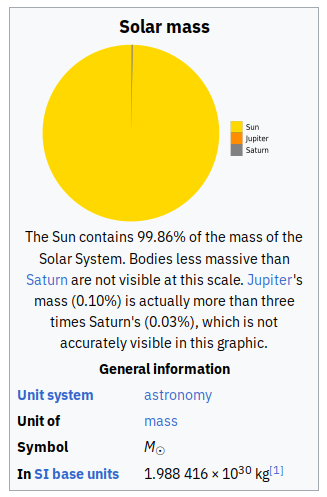Related: https://xkcd.com/2898/

Jokes aside : being right for the wrong reasons is being wrong
https://en.wikipedia.org/wiki/Gettier_problem
Unjustified true belief
Thanks for the read !
It’s not wrong. The “common center” lies inside the Sun.
Therefore, the Sun orbits itself and the Earth orbits the Sun.
The Man-in-the-middle’s statement is akin to the following :
2 = 3 thus, by multiplying both sides by 0, we get 0 = 0, which is true !
He said it’s in the middle because 2 people disagreed, and he states that the truth lies always in she middle in these situations. which is false, exactly as false as 2 = 3
If we’re strict, being right is always being right. If we’re not strict, wouldn’t that imply that being wrong “for the right reasons” is being right?
I believe that’s the same for every planet. And every moon. For every orbit.
Its just that the barycenter is inside the more massive object when one is much more massive than the other. Not that this makes much of a difference to anything.
Correct.
I also believe that one of the criteria for a binary planet is that the barycenter is outside either body. Like Pluto/Charon.
Don’t forget the other 3 bodies in the Pluto/Charon system
Is that a problem?
depends! do you wanna know how the system will evolve over long periods of time?
… then yes!
So you’re saying it’s a Three-Body Problem
Technically 5, but yes
I’ve always preached inclusivity and would welcome 3 more planets
I just can’t remember their names :-(
Same. That’s why I was lazy and didn’t even mention them ;)
The only one I remember is Styx cause I remember the river from mythology cause I thought it was cool. Not a damn clue what the others were.
Oh yeah! Also Nix and Hygea i think.
I mean, sure, but that’d be like saying I’m pulling the earth towards me when I jump.
You don’t have to jump, you’re already doing it. Some of us more than others… *Looks in mirror and hangs head
Isn’t that canceled out by the pushing you do when you start to jump?
Yeah, but then I pull it back as I’m falling.
If you have ever done a handstand then you have lifted over your head the weight that the entire mass of the earth has in your own gravitational field.
Pluto and it’s biggest moon Charon about for the very center outside of each other. This means that you could build a space elevator directly between the surface of each of them and it would rotate around that point since they’re also tightly locked.
Asteroids everything does to some degree even if miniscule I’d assume.
The barycenter is sometimes outside the diameter of the sun. Not always, and I believe not even usually.
Yes, today I’m being that guy. Still a cool factoid.
I’m kinda stunned that it’s EVER outside the sun.
Yeah, that’s the first thing I checked reading the og post before I was about to write ‘there is no was it’s outside the sun!’ … its such a tiny supergassy mass.
Outside the sun? Typical Visiblist. The Alfvén surface would like to have a word. https://en.m.wikipedia.org/wiki/Alfvén_surface
Well, while we are being ‘that guy’, factoid is one of those words which has changed its meaning by being used wrongly for so long that the original meaning has all but vanished.
A factoid is technically supposed to be something resembling fact, but not actual fact. (The Greek suffix ‘-oid’ normally being used for that purpose, like in paranoid, “like knowledge” or asteroid, “like a star”).
The best thing about factoid, is that factoid is now a factoid. Because it resembles what it is not lol…
Anyway, nowadays, you are allowed to use it the way you did, at least in the descriptivist world view. The prescriptivists may disagree, however. And those people are often ‘that guy’ ;)
Since definitions are not facts, the word factoid itself being a factoid is a factoid
I like this
I’d say that the original statement not including “sometimes” does in fact make it the ‘not a fact’ type of factoid!
Good point!
Well, now I want to know if there’s a regular schedule to the Jupiter-Sun barycenter being in or outside of the Sun, and how we can schedule holidays around it.
The way this is phrased makes it sound like there’s a certain threshold where this starts happening. That’s not right. Even a grain of dust wouldn’t orbit the sun, they still orbit their common barycenter. A less misleading way of phrasing would be that Jupiter is massive enough that the barycenter of it and the sun actually lies outside the sun, which is still a cool fun fact.
I mean that’s literally the point the image is trying to make. The last sentence says the point is outside the sun for Jupiter.
I don’t think nitpicking the title achieves anything and it’s not even misleading unless it’s only taken in isolation.
It says it’s so massive they orbit a common point. That directly implies this only happens over a certain mass.
It says it’s so massive they orbit a common point outside the sun. Smaller planets don’t have their common point outside the sun.
I mean, the sentence either implies what I said before, or it implies that the barycenter is a point outside the sun. I really don’t see any other reading than those two.
That’s the way I understood it at first. But after reading it again after reading the comments above, I can see the other way of viewing it. I do agree with you that how the sentence is currently written it’s confusing.
Yeah pretty much my point. I know you can maybe kinda construe it into the truth if you already know about the topic, like other commenters age saying, but it’s presented as educational, and does a poor job at educating with how misleadingly it is phrased.
That’s still not entierly mass dependant, the point is at a distance based on a ratio between the two masses, if Jupiter were closer to the sun then the point would be inside the sun. Its still impressively massive to pull the point outside of the sun at any functional distance but so could a grain of dust with sufficient distance and a big empty universe to prevent anything else from interupting things.
Orbiting a point within the sun is still orbiting the sun.
But orbiting a point 1 meter outside the sun is not orbiting the sun?
Kinda feels intuitively correct
The sun isn’t a perfect sphere.
I was going to complain about the use of “barycenter” instead of the more commonly known “center of mass”. But after some searching, I guess barycenter is more obscure because it’s more specific. I’m ok with that.
[
 ]
]So the Sun is wobbling arround, because of the 3 giants. Fascinating.
3D makes it 100 times better!
Well, mostly Jupiter and a little bit of Saturn.

Like a brick in a washing machine
The link in your post links to a different image. Was that on purpose?
Oopsy, fixed.
Links to some AI slop
Yeah, i forgot how to post an image here without uploading it, so i used a random pic from that site to copy the Markdown code.
I wish that was updated for the current year (and beyond) It’s important to know when giving OP’s statement whether it’s outside the sun at the moment
Here you go:

Your mom’s so fat, she pushes the barycenter of the solar system outside of the diameter of the Sun
Top tier comment right here!
i mean, with that logic, nothing orbits anything
For most bodies the barycenter, while not the same as the center of mass, is still inside the sun. This one isn’t, making it notable
No, this is actually really relevant. This is part of the logic applied to labeling Pluto a dwarf planet. Pluto and it’s moon do this, Earth and our moon do not. Yes, obviously the center of mass of the two isn’t the exact center of the earth but it’s still within the earth.
Asking a physicist about the center of an object is like asking a Tumblr user about thr color of the sky. The only response will be “which one?” And a sigh of exhaustion
Center of volume ≠ center of mass ≠ center of systemic gravity ≠ center of lift…
Not to mention “an object” is just a construct describing a collection of molecules that themselves don’t necessarily sit still or all stick around.
but the density of an object is variable. i mean you can define the diffrence between an orbit and a co-spiral to be based on the physical size of the denser planetary body containing the orbit center point, though that seems arbitrary.
And Pluto knows that Pluto’s
Hot shit
And you know Pluto knows it
“I won’t ever be a planet
It don’t matter 'cause I know that I’m still”
Hot shit
“And you’re hot shit too, so get out of your brain And just do what you’re supposed to do”
You’re not wrong. Everything orbits the center of mass of the system, meaning the mass of the star and the body in orbit. And that is handy for astronomers, many exoplanets have been found using the Doppler spectroscopy method. Doppler spectroscopy measures the Doppler shift in the star’s light as it is pulled towards and away from us by planets in orbit. The newest spectrographs are sensitive enough to detect a star’s wobble caused by an Earth sized body in orbit. The barycenter is still within the star, but not at the center of the star’s mass.
Fun fact: You actually pull the Earth up with the same force it pulls you down… Newton’s Third Law.
I’ve been told that certain peoples mothers happen to pull the earth with a bit more force than others.
Thats a pretty thick attraction. Newtons 7. Street Law.
In a field of study where it’s not just acceptable, but prudent to round pi to “1” because the numbers are that big….
I gotta say, it’s close enough to say Jupiter orbits Sol. Just saying.
Nah, there is no way any astronomer studying orbital mechanics in our solar system is rounding pi to 1. There is virtually no practical calculation you could do on the mechanics of the sun or planets where rounding a known constant by a factor of 3 would yield any useful result whatsoever.
Rounding pi to 1 only makes sense when the uncertainty in the numbers is large, not the magnitude of the numbers, and we know the masses and distances of the objects in our solar system to an amazing level of precision!
Plus, the fact that Jupiter is massive enough to actually exert an influence that large on the sun is pretty fucking cool!

The reason being, that once you go large enough, a multiplier of three is irrelevant, and they only really care about orders of magnitude. You might be tempted to argue that that doesn’t happen inside the solar system, and you’d be right. Mostly.
Except that astronomy doesn’t concern itself with just our system. So yes. Astronomers do frequently round to 1 because it really doesn’t matter that much in the scheme of things. (particularly talking about distances.) it’s even more so for cosmology.
Sure, I totally agree that when you’re dealing many with orders of magnitude, the factor of 3 is dwarved by the other uncertainties.
But we’re talking about our solar system, and specifically the orbital mechanics of our planets and sun, where the quantities and scales only span a couple orders of magnitude in total. A factor of 3 absolutely makes a difference. That’s the difference between the orbit of Mercury and the orbit of Earth.
Then there’s the practical point that, regardless of scale, rounding a known constant by that much makes no sense at all, unless you’re trying to estimate huge numbers in your head. If you’re using even the simplest of calculator, estimating pi as 1 is a deliberate choice to reduce accuracy.
This. Most calculators and programming languages already have pi defined, there is no reason to round it nowadays
Not when that definition of pi goes to all 300 trillion decimals that we have resolved. (To be fair, I don’t know of any that do… but eh…yeah. And I’m pretty sure it was defined by a masochist if one did.)
That leads to unnecessary time spent calculating even simple equations. That level of precision is almost never actually needed.
With fermi problems, usually that level of precision is moot and potentially a waste of time. (Particularly when the math is requiring some kind network cluster to do.)
Pi has it’s own button on most graphing calculators, and those that don’t usually only requure 2 button presses to get it. Meanwhile, there’s some iteration of ‘pi()’, ‘pi’, etc. in most programming languages
Sure.
But sometimes, the problems are complex enough that solve time becomes a concern. When they’re complex enough, you start asking “is everything these precise enough to justify that” and when the answer is “no”, then you don’t do that because runtime on networked clusters like AWS costs money.
And when you’re talking about scales that encompass the galaxy…. Well. There’s just not a lot of precision there to begin with.
You’ve got to be a little bit careful, surely, because then one squared is ten in the sense that log pi is about half.
Just wait until you see their periodic table of elements.
H, He, Z
this disgruntled me as a biochem grad and we think the periodic table is
H C N O P S Na Mg Cl K Ca Mn Fe Co Cu Zn Se Mo I F
Rounding pi to 1? Not even 3? Source please? Because what?
fermi approximations happen all the time in astronomy. The numbers are frequently so large that the only meaningful quality is how many orders of magnitude it has.
More to the point, using pi makes calculating things much harder. For example, we don’t really need a precise distance for most things; so using “3” makes the calculation unnecessarily spend time in computation.
It’s like the old joke, “what’s the difference between a millionaire and a billionaire?” (“About a billion.”)
Is it more true to say that Jupiter (and the other planets and asteroid belts and dust clouds in our solar system) orbits the Sun, and the Sun orbits the barycenter? The barycenter that the sun revolves around is influenced (marginally) by the other bodies in the solar system and not just Jupiter. If the definition of a barycenter is to be interpreted as this image suggests, that would mean that no material object orbits another material object and they instead orbit their collective center of mass somewhere in space.
Edit: to clarify, I understand the physics and motion at play. The phrasing just seems misleading/incorrect to me.
no material object orbits another material object and they instead orbit their collective center of mass somewhere in space.
That’s exactly what happens. Why do you think this is incorrect?
It seems to fundamentally change what it means “to orbit” something.
As I understood the term, orbiting would be used correctly in these cases:
-
A lighter object orbits a heavier object, and both of their paths of motion are elliptical about their barycenter
-
Two objects of identical mass orbit each other, and their paths of motion are circular about their barycenter
In contrast, the image above implies the following:
-
A lighter object does not orbit a heavier object; they both orbit their barycenter with an elliptical path of motion
-
Two objects of identical mass do not orbit each other; they both orbit their barycenter with a circular path of motion
Even the Wikipedia page for barycenter, which OP linked to, opens with the following:
“the barycenter… is the center of mass of two or more bodies that orbit one another and is the point about which the bodies orbit.”
Perhaps “orbit” as a verb has two meanings, depending on the specificity of the context.
I guess your conclusion is right. In situations where the barycenter of two (or more) objects is not sufficiently different from the center of mass of the heaviest object, we simplify the description by assuming that the barycenter and the center of mass of the heavier object are equal.
Just because I’ve already edited it, here’s an animation of Earth orbiting the Earth–Moon barycenter:

No, your earlier definitions are incorrect. All orbits happen around the barycenter. The only question is whether one of the bodies is large/massive enough that the barycenter is located within it
I mean, the Wikipedia page for Jupiter says “Jupiter orbits the Sun”
Just because a more accurate description exists, doesn’t mean that the less accurate description is fundamentally wrong. Depending on context, the less accurate description may be perfectly suitable for the subject at hand. If your priority is to be the most correct, then by all means go ahead and use the more accurate description.
I think this logic applies to a lot of things.
I take issue with how the meme says “Jupiter doesn’t orbit the Sun”, which rejects one valid and common way of using the verb “to orbit”.
It’s articulated as “it’s wrong”, while the message they’re trying to convey is more like “it’s not the entire truth”. The latter is hard to get across is a handful of words though, likely leaving more questions than answers. I believe they did a decent enough job that most of us can read the point between the lines.
-
I thought it was a like Jerryboree but for Barys, which I think makes way more sense.
Jerry loves Pluto, but Bary thinks very little of it
I found it super helpful to have the Sun’s center of mass labeled!
I only wish Jupiter’s center of mass was also labeled in this graphic. I’ve been trying to puzzle it out myself, but I’m stumped!
I think if it’s to scale, Jupiter is way offscreen, like in another room in your building far away.
Do all the planets also orbit around that same barycenter, or does each planet have a different one?
I guess they all orbit around the solar system’s center of mass (negligibly affected by the universal CoM), but that CoM probably moves around as the planets themselves move.
Relative to what, you might ask? That depends who you’re asking 😉
deleted by creator
All the solar system matter contributes to an object’s orbital center but that’s constantly moving as the system moves.
I think (?) most planets have their barycenter inside the sun’s surface
The gravitational pull of system matter pales in comparison to the sun so you don’t need to consider it for amateur purposes.
You can try KSP (Vanilla) versus Kopernicus mod if you want to feel the difference.
Also called n-body
Technically speaking, no celestial body in our solar system orbits around a single point. The barycenter thing only works with two bodies. When there are more than two bodies, such as in our solar system, the orbits become chaotic. Granted, the influence between planets is small, so they all appear to orbit their barycenters with the sun, but there are small perturbations to the orbits caused by the locations and masses of all the other bodies in the solar system.
Isn’t that the 3-body-problem? That already with 3 bodies affecting each other a system is chaotic.
The barycenter is different for each planet-sun (or any two object) pairing.
The earth and moon have a barycenter which is beneath the surface of earth. Likewise, the barycenter of the sun-earth pair is below the surface of the sun
Edit:
The barycenter of our solar system orbits the center of our galaxy (again in a barycentric manner)
Jupiter is so massive, if you give it more hydrogen, it gets smaller.
My dumb friend wants to know why adding more mass would make Jupiter smaller, can you help explain it to him?
I misrembered, it remains roughly the same volume, until 1.6 juipiters of mass, at which point the effect of gravity from each additional hydrogen is greater than the intermolecular forces and additional hydrogen would cause it to compress more than it would grow.
Thanks for the explanation, clears it up completely.
The increased mass increases the force of gravity on the outer particles which ends up reducing the radius more than the increase due to the layer of new hydrogen, IIRC.
Thank you - my friend was only thinking in terms of smaller by mass not thinking about volume.
Imagine a stack of glass cups. It gets tall enough that the bottom glasses break under the weight of the new glasses. Tada!
The volume of Jupiter is mostly gas. If you increase the mass enough, at some point the higher gravity and thus higher pressure at the center causes a phase change of enough mass (from gas to liquid or liquid to solid) that the lost volume from the phase change exceeds the original volume of the added mass.
It’s like pushing a bunch of origami paper into a box until a bunch of them collapse and fall flat instead of filling the volume.
My friend is silly - he was thinking of smaller as in by mass, not by volume. Thanks for explaining it to him.
Is your friend the same crazy person I know who doesn’t eat meat? Are they crazy?
_i don’t know why your comment made me think of that reference _
…
Lots of people don’t eat meat.
It’s a Simpsons quote.
Fun fact: if I threw a rock hard enough, it and the sun would orbit around their “barycenter” which would happen to be just about the center of the sun (probably, i dont work here).
That’s why I lose my balance!
Jeeezzz…Gravity is relentless.
Gravity always wins
Dark energy would like a word

















